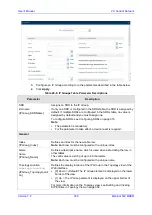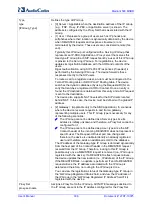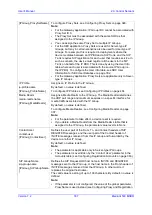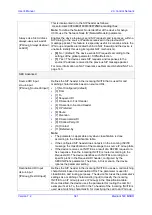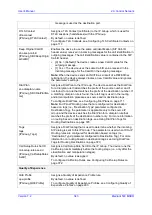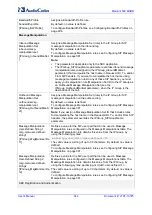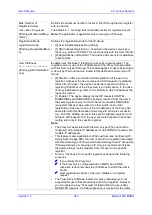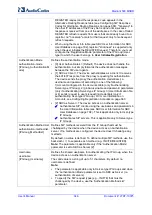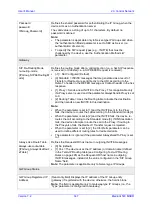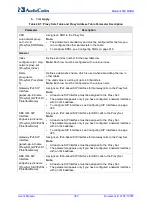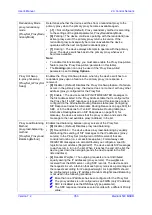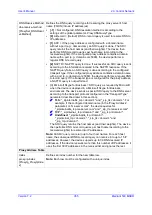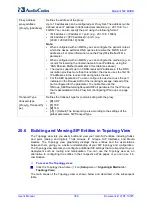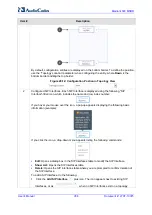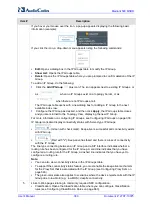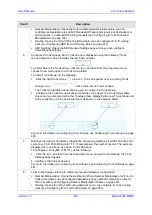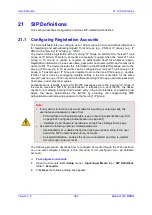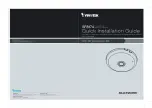
User's Manual
348
Document #: LTRT-10375
Mediant 500 MSBR
GW Group Registered
Status
(Read-only field) Displays whether the IP Group entity (gateway) is
registered with the device ("Registered" or "Not Registered").
Note:
The field is applicable only to Gateway-type IP Groups (i.e., the
'Type' parameter is configured to Gateway).
20.5 Configuring Proxy Sets
The Proxy Sets table lets you configure up to 102 Proxy Sets. A Proxy Set defines the
address and transport type (e.g., UDP or TCP) of a SIP server (e.g., SIP proxy and SIP
registrar server). The Proxy Set represents the destination (address) of the IP Group
configuration entity. Each Proxy Set can be configured with up to 10 addresses configured
as an IP address and/or DNS host name (FQDN), enabling you to implement load
balancing and redundancy (Proxy Hot-Swap feature) between multiple servers. Each Proxy
Set can be assigned a specific SSL/TLS certificate the (TLS Context), enabling you to use
different TLS certificates per SIP entity (IP Group). In addition, each Proxy Set must be
assigned a SIP Interface (and SRD), which determines, amongst others, the device's local
network interface through which communication with the Proxy Set is done.
You can enable the device's keep-alive feature per Proxy Set, which determines whether
proxies (addresses) configured for the Proxy Set are online or offline. If offline, the device
will not route the call to the specific proxy. You can configure the device to send either SIP
OPTIONS or REGISTER messages for the keep-alive. The keep-alive feature is required
when using the proxy load-balancing or redundancy feature. For load-balancing, the device
performs keep-alive on all proxies. For Parking-type redundancy, the device performs
keep-alive only on the currently active proxy. For Homing-type redundancy, the device
performs keep-alive on the current proxy as well as the "main" proxy. When using SIP
OPTIONS, you can configure the device to consider the proxy as offline if specific SIP
response codes are received from the keep-alive messages. To ensure that a previously
offline proxy is now online, you can configure the number of required consecutive
successful keep-alive messages (SIP OPTIONS only) before the device considers the
proxy as being online. This mechanism avoids the scenario in which the device falsely
detects a proxy as being online when it is actually offline, resulting in call routing failure. To
view the connectivity status of Proxy Sets, see Viewing Proxy Set Status on page 868.
You can also enable the device to classify incoming SBC SIP dialogs to IP Groups, based
on Proxy Set. If the source address of the incoming SIP dialog is the same as the address
of a Proxy Set, the device classifies the SIP dialog as belonging to the IP Group that is
associated with the Proxy Set.
To use a configured Proxy Set, you need to assign it to an IP Group in the IP Groups table
(see Configuring IP Groups on page 333). When the device sends INVITE messages to an
IP Group, it sends it to the address configured for the Proxy Set. You can assign the same
Proxy Set to multiple IP Groups (belonging to the same SRD).
Note:
•
It is recommended to classify incoming SIP dialogs to IP Groups, based on the
Classification table (see Configuring Classification Rules on page 663) instead of
based on Proxy Set.
•
You can view the device's connectivity status with proxy servers in the Tel-to-IP
Routing table, for Tel-to-IP routing rules whose destination is an IP Group that is
associated with a Proxy Set. The status is only displayed for Proxy Sets enabled
with the Proxy Keep-Alive feature.
The Proxy Set is configured using two tables, one a "child" of the other:
Proxy Sets table: Defines the attributes of the Proxy Set such as associated SIP
Summary of Contents for Mediant 500 MSBR
Page 2: ......
Page 33: ...Part I Getting Started with Initial Connectivity ...
Page 34: ......
Page 36: ...User s Manual 36 Document LTRT 10375 Mediant 500 MSBR This page is intentionally left blank ...
Page 40: ...User s Manual 40 Document LTRT 10375 Mediant 500 MSBR This page is intentionally left blank ...
Page 45: ...Part II Management Tools ...
Page 46: ......
Page 48: ...User s Manual 48 Document LTRT 10375 Mediant 500 MSBR This page is intentionally left blank ...
Page 115: ...Part III General System Settings ...
Page 116: ......
Page 132: ...User s Manual 132 Document LTRT 10375 Mediant 500 MSBR This page is intentionally left blank ...
Page 137: ...Part IV General VoIP Configuration ...
Page 138: ......
Page 290: ...User s Manual 290 Document LTRT 10375 Mediant 500 MSBR This page is intentionally left blank ...
Page 306: ...User s Manual 306 Document LTRT 10375 Mediant 500 MSBR This page is intentionally left blank ...
Page 380: ...User s Manual 380 Document LTRT 10375 Mediant 500 MSBR This page is intentionally left blank ...
Page 454: ...User s Manual 454 Document LTRT 10375 Mediant 500 MSBR This page is intentionallty left blank ...
Page 455: ...Part V Gateway Application ...
Page 456: ......
Page 460: ...User s Manual 460 Document LTRT 10375 Mediant 500 MSBR This page is intentionally left blank ...
Page 484: ...User s Manual 484 Document LTRT 10375 Mediant 500 MSBR This page is intentionally left blank ...
Page 494: ...User s Manual 494 Document LTRT 10375 Mediant 500 MSBR This page is intentionally left blank ...
Page 625: ...Part VI Session Border Controller Application ...
Page 626: ......
Page 654: ...User s Manual 654 Document LTRT 10375 Mediant 500 MSBR This page is intentionally left blank ...
Page 656: ...User s Manual 656 Document LTRT 10375 Mediant 500 MSBR This page is intentionally left blank ...
Page 741: ...Part VII Cloud Resilience Package ...
Page 742: ......
Page 751: ...Part VIII Data Router Configuration ...
Page 752: ......
Page 753: ......
Page 754: ......
Page 756: ...User s Manual 756 Document LTRT 10375 Mediant 500 MSBR This page is intentionally left blank ...
Page 757: ...Part IX Maintenance ...
Page 758: ......
Page 834: ...User s Manual 834 Document LTRT 10375 Mediant 500 MSBR This page is intetnionaly left blank ...
Page 837: ...Part X Status Performance Monitoring and Reporting ...
Page 838: ......
Page 848: ...User s Manual 848 Document LTRT 10375 Mediant 500 MSBR This page is intentionally left blank ...
Page 852: ...User s Manual 852 Document LTRT 10375 Mediant 500 MSBR This page is intentionally left blank ...
Page 854: ...User s Manual 854 Document LTRT 10375 Mediant 500 MSBR This page is intentionally left blank ...
Page 878: ...User s Manual 878 Document LTRT 10375 Mediant 500 MSBR This page is intentionally left blank ...
Page 880: ...User s Manual 880 Document LTRT 10375 Mediant 500 MSBR This page is intentionally left blank ...
Page 926: ...User s Manual 926 Document LTRT 10375 Mediant 500 MSBR This page is intentionally left blank ...
Page 927: ...Part XI Diagnostics ...
Page 928: ......
Page 950: ...User s Manual 950 Document LTRT 10375 Mediant 500 MSBR This page is intentionally left blank ...
Page 954: ...User s Manual 954 Document LTRT 10375 Mediant 500 MSBR This page is intentionally left blank ...
Page 956: ...User s Manual 956 Document LTRT 10375 Mediant 500 MSBR This page is intentionally left blank ...
Page 958: ...User s Manual 958 Document LTRT 10375 Mediant 500 MSBR This page is intentionally left blank ...
Page 974: ...User s Manual 974 Document LTRT 10375 Mediant 500 MSBR This page is intentionally left blank ...
Page 976: ...User s Manual 976 Document LTRT 10375 Mediant 500 MSBR This page is intentionally left blank ...
Page 977: ...Part XII Appendix ...
Page 978: ......
Page 982: ...User s Manual 982 Document LTRT 10375 Mediant 500 MSBR This page is intentionally left blank ...


